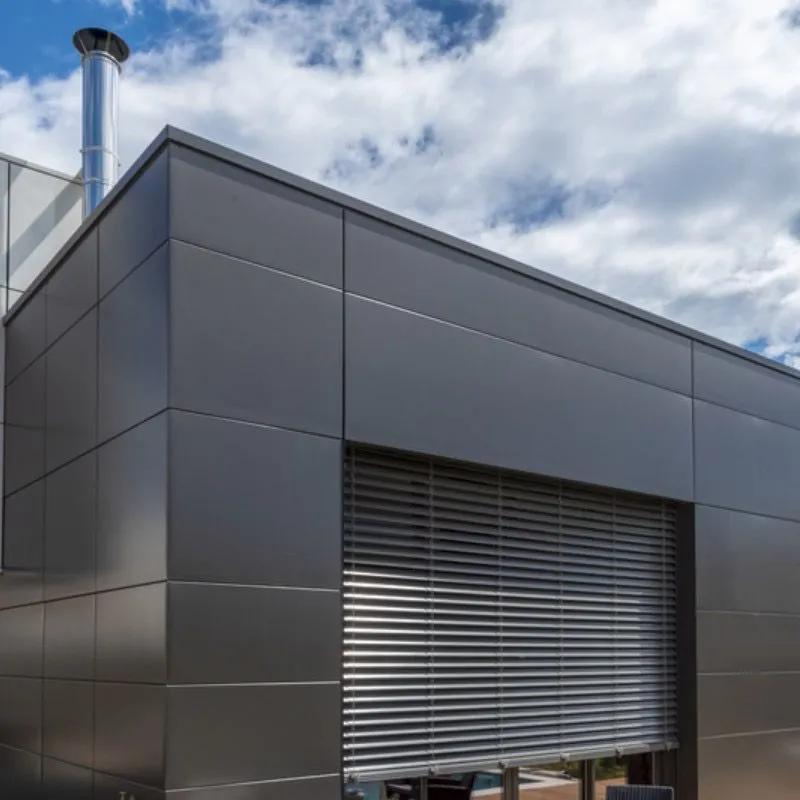Why Are Aluminum Composite Panels a Popular Choice for Modern Architecture?
2024-12-11
Aluminum composite panels (ACPs) have become a staple in the construction and design industries, particularly for modern architecture. But what makes these materials so popular and versatile? From their aesthetic appeal to their durability, aluminum composite panels offer numerous benefits that have made them a go-to choice for exterior and interior applications alike.
1. What Is an Aluminum Composite Panel?
Aluminum composite panels are made up of two thin layers of aluminum surrounding a non-aluminum core, usually polyethylene or a fire-resistant mineral core. This combination of materials gives ACPs a unique set of properties that make them ideal for a variety of uses in construction, signage, and interior design. The exterior aluminum layer can be coated with a variety of finishes, including metallic, matte, or gloss, offering endless design possibilities.
2. Why Are Aluminum Composite Panels So Durable?
One of the main reasons ACPs are favored in architecture is their exceptional durability. The aluminum exterior provides resistance to corrosion, UV rays, and harsh weather conditions, ensuring that the panels maintain their appearance and structural integrity for many years. Whether in urban environments, coastal areas, or extreme climates, aluminum composite panels are built to withstand the elements, making them an excellent choice for both residential and commercial buildings.
The core material also plays a significant role in the panel's strength. Depending on the type of core used, ACPs can provide sound insulation, thermal insulation, and even fire resistance, which makes them not only durable but also safe and energy-efficient.
3. How Do Aluminum Composite Panels Enhance Aesthetic Appeal?
ACPs are widely used in modern architecture due to their sleek, clean appearance and versatility in design. With the ability to produce panels in a wide range of colors, textures, and finishes, architects and designers have a virtually limitless palette to work with. Aluminum composite panels can mimic the appearance of materials like wood, stone, and concrete while providing the added benefits of lightweight and easy maintenance.
Moreover, ACPs can be fabricated into different shapes and sizes, allowing for unique, custom designs. This flexibility helps architects create distinctive facades, innovative signage, and visually striking interior spaces that are both functional and aesthetically pleasing.
4. What Are the Environmental Benefits of Aluminum Composite Panels?
Aluminum is a highly recyclable material, and many aluminum composite panels are made using recycled content. This makes them a more sustainable choice compared to other construction materials. The longevity and low maintenance requirements of ACPs also contribute to reducing their environmental impact over time. The durable nature of these panels means that they do not need frequent replacements, which further minimizes waste.
Additionally, the energy efficiency of aluminum composite panels helps reduce the overall energy consumption of buildings. By providing better thermal insulation, they can help regulate the temperature inside the building, reducing the need for heating and cooling.
5. How Do Aluminum Composite Panels Contribute to Safety?
Safety is another key consideration when choosing materials for construction projects, and aluminum composite panels excel in this area. Many ACPs are fire-resistant, especially those with mineral cores, which can provide a higher level of fire protection compared to standard materials. This feature is particularly important in commercial buildings, high-rise structures, and places with high foot traffic, where fire safety regulations are stringent.
In addition to fire resistance, ACPs can also offer soundproofing properties. The materials' structure and core composition can help reduce noise transmission, making them suitable for use in areas requiring acoustic insulation, such as office buildings, schools, and hospitals.
6. Why Are Aluminum Composite Panels Easy to Maintain?
Another major advantage of aluminum composite panels is their ease of maintenance. Unlike traditional materials like wood or stone, ACPs are resistant to fading, peeling, or cracking, which reduces the need for frequent repairs or replacements. The smooth surface of the panels makes them easy to clean with just a mild detergent and water, making maintenance simple and cost-effective.
This low-maintenance quality is particularly important for high-rise buildings and large commercial spaces, where frequent upkeep can be both time-consuming and expensive.
7. How Are Aluminum Composite Panels Installed?
The installation of aluminum composite panels is relatively straightforward, especially when compared to other building materials. ACPs are lightweight and easy to handle, which makes them a popular choice for both new construction and renovation projects. They can be mounted on various surfaces, including concrete, metal, and wooden frames, using specialized fasteners or adhesives.
The flexibility of ACPs allows for a wide range of installation methods, such as vertical or horizontal mounting, and can be tailored to suit the specific design requirements of the building. This ease of installation also contributes to reduced labor costs and faster project completion times.
8. What Makes Aluminum Composite Panels Cost-Effective?
Despite their many benefits, aluminum composite panels are considered cost-effective when compared to other materials, such as stone or glass. They offer the look and feel of premium materials without the high price tag, making them a great option for projects with budget constraints. Additionally, their lightweight nature reduces shipping and handling costs, further improving the overall value.
The long lifespan of ACPs, combined with their low maintenance requirements, also means that they offer a great return on investment over time. With proper installation and care, aluminum composite panels can maintain their appearance and performance for decades, making them a wise financial choice for building owners.
9. Why Are Aluminum Composite Panels Used in So Many Applications?
Aluminum composite panels are used in a wide range of applications, from exterior cladding and facades to interior walls, ceilings, and even signage. Their versatility makes them suitable for various industries, including residential, commercial, industrial, and public sector projects.
Whether used to create striking architectural features or functional, durable surfaces, ACPs offer a perfect balance of form and function. Their wide range of applications is one of the reasons they have become a go-to material for modern architecture and design.
Aluminum composite panels have proven to be an indispensable material in modern construction and design. With their durability, versatility, aesthetic appeal, and environmental benefits, it's clear why they have gained popularity in architecture worldwide.



